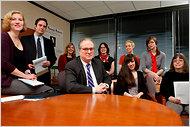James Warren writes a column for the Chicago News Cooperative.
Staff members of The Rotarian. Front, from left: Jenny Llakmani, John Rezek, Margaret Smith and Barbara Ellis. Back row: Marc Duke, Janice Chambers, Diana Schoberg, Shannon Kelly and Donna Polydoros.
Chicago News Cooperative
Playboy Alumni Give an Old Magazine a Slick New Look
By JAMES WARREN
Published: New York Times, March 19, 2011
David Klobucar/Chicago News Cooperative
Chicago News Cooperative
A nonprofit, nonpartisan news organization providing local coverage of Chicago and the surrounding area for The New York Times.
Jim Petersen, a motorcyclist, cannot have charted a more curious course than what has taken him to the Evanston offices of the 1.2-million-member Rotary International.
For 20 years, Mr. Petersen was a cultural icon of a carnal sort: the Playboy Advisor. When the magazine left Chicago for New York in 2003, he and most of the editorial hierarchy stayed behind, though his post-Advisor life has included doing Playboy motorcycle reviews, sex surveys and articles bearing the byline of the founder, Hugh Hefner.
Now he contributes to The Rotarian, the Rotary International magazine, which is an impressive exception to that often snoozy genre, mostly because of Playboy alumni armed with major league experience, creativity and contacts.
Barbara Nellis, senior editor/features, arrived first. Then came John Rezek, now editor in chief, after a post-Playboy tenure as an award-winning editor of The Bulletin of the Atomic Scientists. Mark Duran, Playboy’s onetime librarian, came as a researcher, and others followed, including Joe Cane, a production specialist, and Paul Engleman, a novelist.
“Long before Facebook there were Rolodexes, in an era where an editor’s primary skill was to build a network of contacts and contributors. Barb brought hers and John brought his,” Mr. Petersen said.
The look, story selection and new contributors — who include P. J. O’Rourke, Alex Kotlowitz, Scott Turow, Guy Billout, Nicholas Kristof and Sheryl WuDunn — are big-time. January’s 100th-anniversary issue was a tour de force, with a cover by the legendary graphic designer Milton Glaser and snippets from past contributors including Jane Addams, Mikhail Gorbachev, Ray Bradbury, Sherwood Anderson, Pearl S. Buck, Arthur C. Clarke, Michael Crichton, Carl Sagan, Babe Ruth, Winston Churchill, Theodore Dreiser and Ernest Hemingway (tips on fishing in Cuba) .
The Hefner refugees inherited a publication that was at times cliché-ridden with mediocre photos. They have made it sophisticated, exploiting the rich material offered by Rotary’s simple, if profound, agenda: to advance world understanding, good will and peace via a fellowship of business, professional and community leaders, with emphasis on health, education and poverty.
Typical of Rotary is a partnership with the Bill & Melinda Gates Foundation. The Gateses are providing $355 million, with Rotary headed toward providing a $200 million match, to eradicate polio, which remains rampant in Afghanistan, India, Nigeria and Pakistan.
Rotarians in Yonkers, N.Y., established a clinic in the Dominican Republic for H.I.V.-infected women and their children. Clubs in Brazil and Jackson Hole, Wyo., combined to collect and distribute breast milk for impoverished infants via a hospital in Bage, Brazil, while Korean Rotarians built a medical complex for maternal health in Kibaha, Tanzania.
It goes on and on, with literacy, water and sanitation projects abounding. Rotary members flew 70 planes with 60,000 pounds of medical equipment and supplies into Haiti after the earthquake last year.
The magazine is strong financially, with nearly $96 million in annual revenues and expenses of $82 million, and with the related Rotary Foundation showing total assets of $731 million.
Rotary was once seen as a proselytizing Middle American, small-town men’s group or social venue for lonely business types in big cities. And it took a 1987 United States Supreme Court ruling before women could join. Now 24 percent of members in North America are female, and 16 percent are female in the 34,103 clubs worldwide.
The coming of women has helped change a culture and, to that extent, made producing a strong publication easier.
No surprise, there have been occasional internal murmurings about the Playboy crowd, and some chagrin over a few editorial efforts that some felt were politically risqué. But, as one effort of Mr. Petersen’s shows, there has been a resolutely shrewd blend of the organization’s mission and the magazine.
Mr. Petersen hopped on his motorcycle and drove 8,000 miles through South and Central America to see a slew of inspiring Rotarian projects, some amid truly dire poverty. In our sound-bite-obsessed age, 20 pages were devoted to an epic by a grateful writer.
“People say I’ve drunk the Kool-Aid,” Mr. Petersen said. “No. I’m just looking at something that’s unsung and one of America’s better ideas. It’s people saying, ‘Be a good citizen in your community.’ ”
